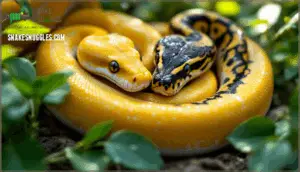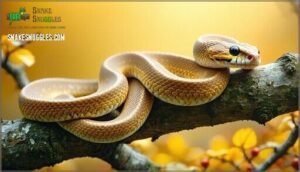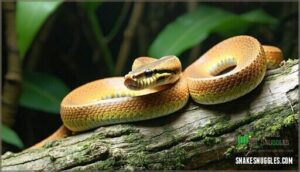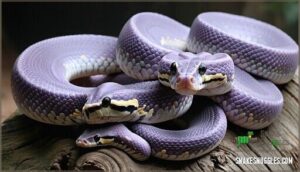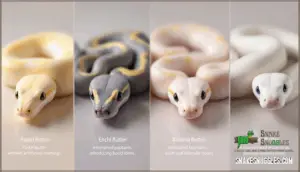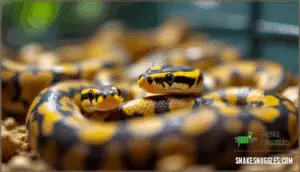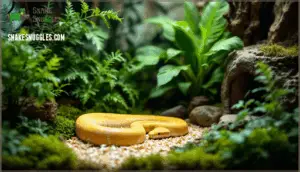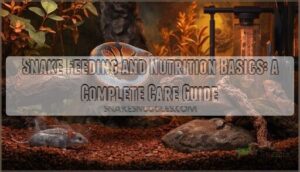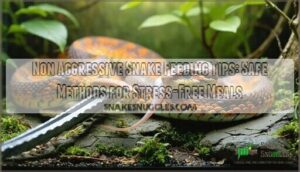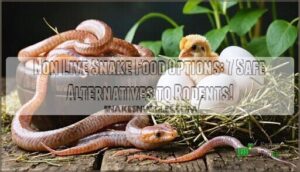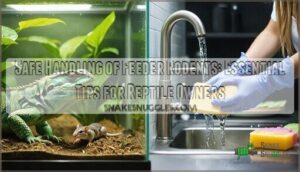This site is supported by our readers. We may earn a commission, at no cost to you, if you purchase through links.
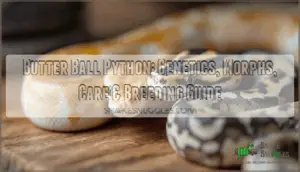
But genetic testing in 2025 confirmed what top breeders suspected: the Butter descended from a completely separate wild bloodline. That distinction matters because it unlocks different breeding outcomes and explains why Butters show warmer tones and cleaner lines than their look-alike cousins.
Whether you’re hunting for your first morph or planning complex genetic pairings, understanding what sets the Butter apart gives you control over your collection’s future.
Table Of Contents
- Key Takeaways
- What is a Butter Ball Python?
- Genetics and Inheritance of The Butter Morph
- Popular Butter Ball Python Morph Variations
- Breeding, Pricing, and Availability
- Care, Housing, and Ownership Considerations
- Frequently Asked Questions (FAQs)
- What is a butter ball python?
- Are butter and lesser ball pythons the same?
- What is a butter morph?
- What is a banana ball python?
- What distinguishes butter from lesser ball pythons?
- How does the butter gene affect python coloration?
- Are Butter Ball Pythons easy to handle?
- What feeding practices are recommended for butter morphs?
- How to maintain optimal humidity in their enclosure?
- How long do Butter Ball Pythons typically live?
- Conclusion
Key Takeaways
- The Butter ball python was proven genetic in 2001 by Mark and Kim Bell, and genetic testing in 2025 confirmed it’s a completely separate bloodline from the Lesser Platinum—despite their similar appearance—which unlocks different breeding outcomes and explains the Butter’s warmer tones and cleaner lines.
- Butter follows co-dominant genetics, meaning one copy produces the standard caramel-and-yellow morph while two copies create a Super Butter (Blue-Eyed Leucistic)—a pure white snake with blue eyes—giving breeders predictable control over visual outcomes.
- Combining Butter with other morphs like Pastel, Enchi, or Banana creates distinct designer combinations that range from enhanced contrast and brightness to lavender-kissed purples, making it one of the most versatile base morphs for breeding projects.
- Proper care requires a temperature gradient of 78-92°F, 50-60% humidity, appropriately sized frozen prey every 7-14 days depending on age, and commitment to a 20-30 year lifespan with annual veterinary care from a reptile specialist.
What is a Butter Ball Python?
The Butter ball python is a striking morph that stands out in the snake-keeping world. It was first proven genetic in 2001 by Mark and Kim Bell of Reptile Industries.
Let’s break down what makes this morph special and why it’s become a staple in breeding programs.
Definition and Origin
The Butter ball python first emerged from the breeding program of Mark and Kim Bell at Reptile Industries, who proved it as a genetic morph in 2001. This breeding achievement established the Butter’s place among ball python morphs with distinct genetic roots.
Initially, breeders thought Butter and Lesser shared the same gene. But in 2025, Rare Genetic Inc confirmed these ball pythons descended from separate wild origins, making Butter its own genetic line.
Distinctive Characteristics and Appearance
You’ll notice the Butter’s coloring right away—soft yellow patterns draped over a warm caramel-brown body that feels almost velvety to look at. These color morphs show cleaner lines than many ball python morphs, with background hues that stay consistent from head to tail.
The scale texture appears smooth, while eye coloration remains dark and expressive, making Butter ball pythons instantly recognizable in snake genetics and coloration discussions.
Comparison to Lesser Platinum and Other Morphs
While those warm tones catch your eye, don’t confuse Butter with Lesser Platinum—they’re genetically different despite looking nearly identical. Here’s what sets them apart:
- Butter descends from a distinct wild-collected bloodline confirmed by Reptile Industries in 2001
- Lesser Platinum carries separate co-dominant genes that weren’t proven until later genetic testing
- Color variations appear subtly warmer in Butter specimens compared to Lesser’s cooler tones
- Breeding outcomes differ when you pair each morph with identical partners
RGI’s 2025 genetic analysis finally settled the debate—these ball python genetics produce different pattern expressions despite their morph similarities. Understanding the genetic mutation of co dominant traits is essential for ball python breeding.
Popularity in The Reptile Trade
That distinct genetic profile turned Butter into one of the most sought-after base morphs for breeders worldwide. You’ll find them dominating reptile shows and breeder networks because they create stunning combinations when paired with other morphs. The exotic pet trade values Butters at $250-$3,500 depending on genetic complexity—making them accessible yet profitable for serious reptile breeding and care enthusiasts.
| Market Factor | Impact on Butter Popularity |
|---|---|
| Reptile Industries proof (2001) | Established legitimacy in reptile industry and market |
| Co-dominant genetics | Unlocks endless breeding possibilities for pet snakes |
| Visual appeal | Drives demand at reptile shows nationwide |
| Price accessibility | Makes pet ownership achievable for hobbyists |
| Trade regulations compliance | Guarantees legal exotic pet trade participation |
Genetics and Inheritance of The Butter Morph
The Butter morph doesn’t follow simple dominant or recessive rules. Its genetics work through co-dominance, which means you’ll see visible traits in the first generation and even more dramatic changes when you breed two Butters together.
Let’s break down how this gene passes from parent to offspring and what happens when you stack it with other morphs.
Co-Dominant and Incomplete Dominant Traits
The Butter morph follows a co-dominant genetic pattern, which means you’ll see visible traits whether your snake inherits one copy or two copies of the gene. With one copy, you get the standard Butter appearance—those soft yellows on caramel-brown. Two copies create the homozygous Super Butter form.
This incomplete dominant mutation allows predictable trait inheritance and exciting morph interactions when you pair Butters with other ball python morphs, giving you control over your breeding outcomes.
The Super Butter and Blue-Eyed Leucistic Forms
When you breed two Butterball pythons together, their offspring don’t show patterns at all—they hatch as stunning white snakes with piercing blue eyes. This Super Butter form is what breeders call a Blue-Eyed Leucistic—a prized ball python morph showcasing:
Breeding two Butter ball pythons creates Super Butter offspring—pure white snakes with striking blue eyes known as Blue-Eyed Leucistics
- Pure white scales with no pattern or color
- Bright blue eye color that stays for life
- Leucistic traits without albinism genetics
- Predictable morph expression using a genetic wizard
This genetic variance gives you complete control over breeding outcomes.
Notable Genetic Combinations (e.g., Killer Blast)
Combining Butter with other dominant genes unlocks bold morph expressions you can predict using a genetic wizard. Killer Blast—Super Pastel, Pinstripe, and Spider—gains enhanced brightness when Butter joins the mix. You’ll see pattern reduction and high-contrast yellows that command attention.
Understanding the genetic combinations and snake breeding techniques is essential for creating unique morphs.
| Morph Combination | Visual Outcome |
|---|---|
| Butter Killer Blast | Enhanced brightness, reduced melanin |
| Biohazard (Butter + Fire + Cinnamon + Super Pastel) | Striking contrast, extreme rarity |
| Killer Queen Bee | Butter + Super Pastel + Spider intensity |
These designer morphs showcase leucistic traits and genetic variability without producing a Blue-Eyed Leucistic.
Popular Butter Ball Python Morph Variations
The Butter gene opens up a world of breeding possibilities when you combine it with other morphs. Each pairing creates distinct visual effects that range from subtle enhancements to dramatic transformations.
Here’s what happens when you mix Butter with some of the most popular ball python genes.
Pastel Butter Ball Python
If you’re craving something that takes the Butter’s caramel warmth and cranks up the contrast, Pastel Butter is where things get visually striking. The Pastel gene brightens those soft yellows and lightens the background, creating a high-contrast look that’s perfect for breeding tips focused on color genetics.
This combo is a favorite in ball python morphs because it’s affordable, proven, and delivers clean morph patterns that showcase reptile genetics beautifully.
Butter Enchi and Other Hybrids
Stack the Enchi gene on top of Butter and you’re unlocking one of the cleanest, most addictive designer combos in the python world. Enchi hybrids bring that blushed, reduced-pattern magic that makes butter genetics pop. Here’s why breeders obsess over this pairing:
- Reduced alien heads create sleeker color patterns
- Enhanced orange and gold tones fuel hybrid vigor
- Cleaner dorsal stripe showcases genetic traits beautifully
- Stackable with other ball python morphs for morph breeding flexibility
- Consistent visual impact across clutches in reptile breeding projects
Other hybrids like Butter Cinnamon or Butter Clown deliver their own snake genetics twists.
Banana Butter and Multi-Gene Combinations
Mix Banana into Butter, and you’re watching two co-dominant powerhouses collide into something that breaks every visual rule you thought ball pythons followed. Gene expression here creates lavender-kissed yellows and blushed purples that defy standard color genetics.
Multi morph stacking with Pastel or Enchi amplifies genetic diversity through hybrid breeding. This combo proves why ball python morph identification demands understanding color mutations beyond surface patterns.
Genetic research in snakes shows these butter ball pythons rewrite ball python breeding expectations with every clutch.
Visual Differences Among Variations
Look at two Butter combos side by side, and you’ll spot differences that genetics alone can’t prepare you for—pattern density shifts, color depth changes, and contrast variations that make each morph combination visually distinct.
Ball python morph identification demands scrutiny because visual genetics behave unpredictably:
- Pastel Butter brightens yellows while thinning snake markings
- Enchi Butter intensifies pattern inheritance with bolder contrast
- Banana Butter introduces lavender hues absent in standard color mutations
- Super Butter erases all color patterns into blue-eyed leucistic white
Genetic traits express differently depending on morph variations present.
Breeding, Pricing, and Availability
Breeding Butters opens up exciting genetic possibilities. Prices vary based on morph combinations and bloodline quality. Finding the right breeder makes all the difference in your purchase experience.
Breeding Strategies and Pairing Options
You can turn your Butter into dozens of stunning combinations by pairing it with the right co-dominant or recessive genes. Genetic pairing with morphs like Pastel or Enchi creates brighter yellows, while hybridization techniques using Clown or Pied introduce unique patterns.
Here’s how snake compatibility affects breeding outcomes:
| Pairing Type | Expected Result |
|---|---|
| Butter × Pastel | Enhanced yellow tones with higher contrast |
| Butter × Clown | Reduced pattern with vibrant color morphs |
| Butter × Banana | Golden hues with unique color morphs in ball pythons |
Your morph selection drives what you’ll produce in snake breeding and ball python care.
Price Range and Market Factors
Once you’ve chosen your pairings, market trends quickly influence what you’ll pay. Butter Ball Pythons range from $250 to $3,500 depending on genetic combinations and breeder fees. Price fluctuation hits hard during peak breeding seasons when auction prices spike for rare morphs.
Resale value stays strong for multi-gene combos, especially on platforms like ReptMart where exotic pets attract serious collectors. The pet industry and commerce around reptile breeding and conservation keeps pushing prices upward as demand outpaces supply in reptile sales.
Finding Reputable Breeders and Sellers
Price matters, but breeder verification matters more. Start with online marketplaces like MorphMarket where over 1,500 breeders post seller reviews and customer feedback. Check reptile regulations in your state before buying.
Platforms like ReptMart offer buyer protection and detailed genetic records. Reputable sources in reptile breeding and conservation maintain veterinary certifications and shipping guarantees.
The reptile industry and research community consistently warns against sellers without documented lineage or health history.
Availability Across Regions and Breeder Listings
Butter morphs show up more often in the US and Europe, but availability shifts fast depending on breeder season and hatch rates. Regional demand and market trends influence which Ball Python breeders stock specific combinations.
You’ll find listings through breeder networks, snake auctions, and reptile expos year-round. Import regulations restrict international purchases, so check local laws before ordering.
Care, Housing, and Ownership Considerations
Owning a Butter Ball Python means you’re taking on a living creature with specific needs. You’ll need to get the basics right—from feeding schedules to cage conditions.
Here’s what you need to know to keep your snake healthy and thriving.
Diet and Feeding Habits
Feeding your Butter ball python the right way keeps it healthy and helps it thrive in captivity. You’ll want to offer appropriately sized frozen prey—usually mice or rats that match your snake’s girth.
Young pythons eat weekly, while adults need meals every 10-14 days. If your snake refuses food, check temperatures or consider breeding season stress.
Proper animal husbandry means no supplementation is needed when you’re feeding whole prey items consistently.
Enclosure Setup and Environmental Needs
Creating the right enclosure for your Butter ball python starts with understanding its natural instincts and environmental triggers. You need a temperature gradient from 78°F on the cool side to 88-92°F at the basking spot. Humidity levels should stay between 50-60%, rising to 70% during shedding.
Choose substrate like aspen shavings or coconut husk for proper animal husbandry. Enclosure size depends on age—start with a 20-gallon tank for juveniles.
Add enrichment items like hides and climbing branches for animal welfare and safety in exotic pet ownership.
Handling, Health, and Veterinary Care
Interacting with your ball python properly safeguards both animal welfare and safety. Wait 1-2 weeks before first contact. Interact gently 1-2 times weekly using two-point support during evening hours. Skip interaction 48 hours post-feeding. Watch for stress signs like hiding, lethargy, or appetite loss.
Maintain 50-60% humidity for disease prevention. Schedule annual vet visits with a reptile specialist. Routine checks for clear eyes and clean vents support pet snake care and breeding success.
Shipping, Delivery, and Long-Term Commitment
Getting your new python home safely is just the beginning of a 20-30 year partnership. Reptile orders ship FedEx overnight Monday through Thursday. Most arrive by 10:30am, though some packages come between 12-4pm. Hold pickup at your nearest FedEx center protects animal safety during extreme weather.
Safe shipping protects animal welfare initially, but your dedication determines lifelong health.
Long-term care demands:
- Consistent feeding schedules for 2-3 decades
- Annual veterinary expenses with reptile specialists
- Humidity monitoring and temperature regulation daily
- Enclosure upgrades as your snake grows
- Financial backup for unexpected health emergencies
Frequently Asked Questions (FAQs)
What is a butter ball python?
Think of it as nature’s own artist palette brought to life. A Butter Ball Python is a co-dominant color mutation with soft yellow markings on a velvety caramel-brown background, first proven genetic in 2001 by Reptile Industries and prized for creating stunning multi-gene combinations.
Are butter and lesser ball pythons the same?
No, they aren’t the same. Butter and Lesser Platinums look similar but come from different bloodlines.
In 2025, Rare Genetic Inc confirmed they’re distinct genes, ending years of historical confusion about these Ball Python color mutations.
What is a butter morph?
A Butter is a co-dominant Ball Python color mutation with soft yellow markings over a velvety caramel-brown base.
Its homozygous form creates a stunning Blue-Eyed Leucistic—pure white scales with sapphire eyes that’ll stop you in your tracks.
What is a banana ball python?
A Banana is a co-dominant snake morph known for its bright yellow and tan coloration with dark spots. When combined with Butter genetics, this breeding combo creates stunning visual variations.
Banana Ball Pythons usually cost more due to their striking appearance and popularity in the reptile trade.
What distinguishes butter from lesser ball pythons?
Twin flames in snake form—Butter and Lesser ball pythons share striking looks but spring from separate wild bloodlines.
RGI Confirmation in 2025 proved these snake morphs are genetically distinct, producing different breeding outcomes despite visual nuances that once fooled breeders.
How does the butter gene affect python coloration?
The Butter gene reduces dark pigmentation and increases yellow pigmentation. This creates soft yellow markings on a caramel background.
Color intensity and pattern variation depend on whether the snake is heterozygous or Super Butter (homozygous Blue-Eyed Leucistic).
Are Butter Ball Pythons easy to handle?
You’ll find these snakes docile and tolerant during Reptile Interactions sessions. Ball Pythons rarely bite when you use safe techniques.
Their calm temperament variations make them suitable even for supervised child interaction, though individual Butter Ball Python personalities differ slightly.
What feeding practices are recommended for butter morphs?
Feed your snake appropriately-sized frozen prey every 7-14 days depending on age. Young snakes eat weekly, while adults eat less frequently. Frozen rodents prevent injuries and parasites.
Refusal to eat can be caused by stress, shedding, or temperature issues.
Proper Reptile Care promotes healthy Snake Breeding.
How to maintain optimal humidity in their enclosure?
You’ll want to monitor Humidity Monitoring levels with a hygrometer, targeting 50-60%. Choose a moisture-holding Substrate Choice like cypress mulch. Position a large Water Bowl for evaporation. Confirm proper Enclosure Ventilation prevents stagnant air.
Poor humidity causes Shedding Issues in your Butter Ball Python.
How long do Butter Ball Pythons typically live?
Like a timekeeper measuring decades, your Butter Ball Python can share 20 to 30 years with you when husbandry impacts are ideal.
Average lifespan depends on factors affecting health—proper pet care and interaction, snake breeding practices, and preventing common diseases all play roles in extending lifespan for these reptile morphs.
Conclusion
Picture your Butter ball python catching light in five years—richer gold tones, sharper borders, a specimen that proves you chose the right foundation morph. You’ve learned the genetics, spotted the differences from Lesser Platinums, and mapped out breeding paths that avoid guesswork. Now you control outcomes instead of hoping for them.
Set up proper care protocols, track lineage records, and watch your investment mature into something breeders notice. Your collection starts with decisions you make today.

